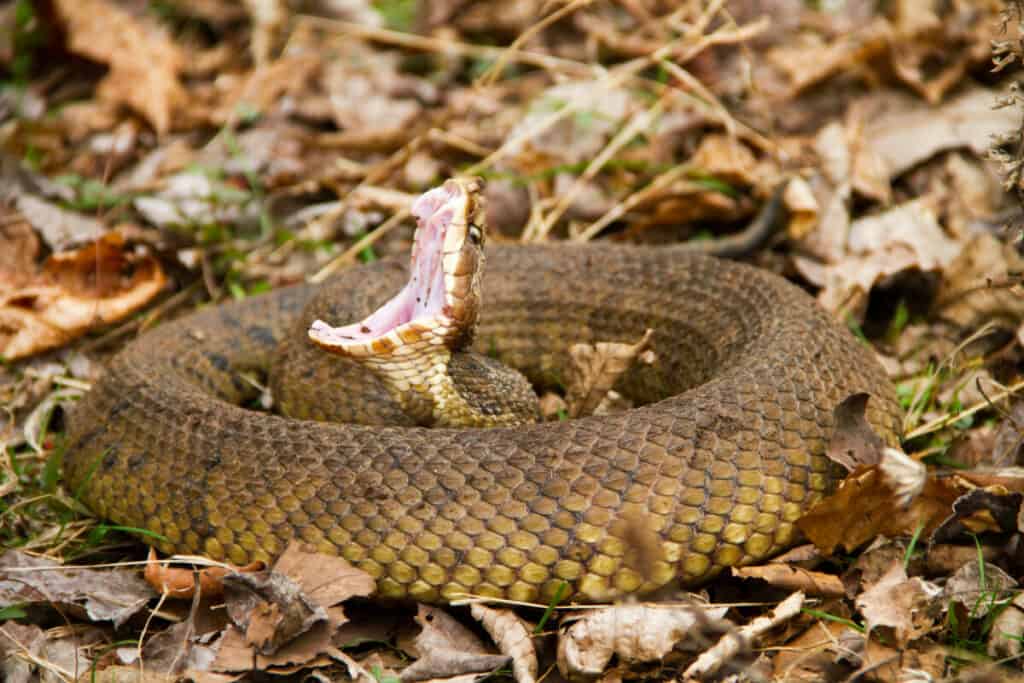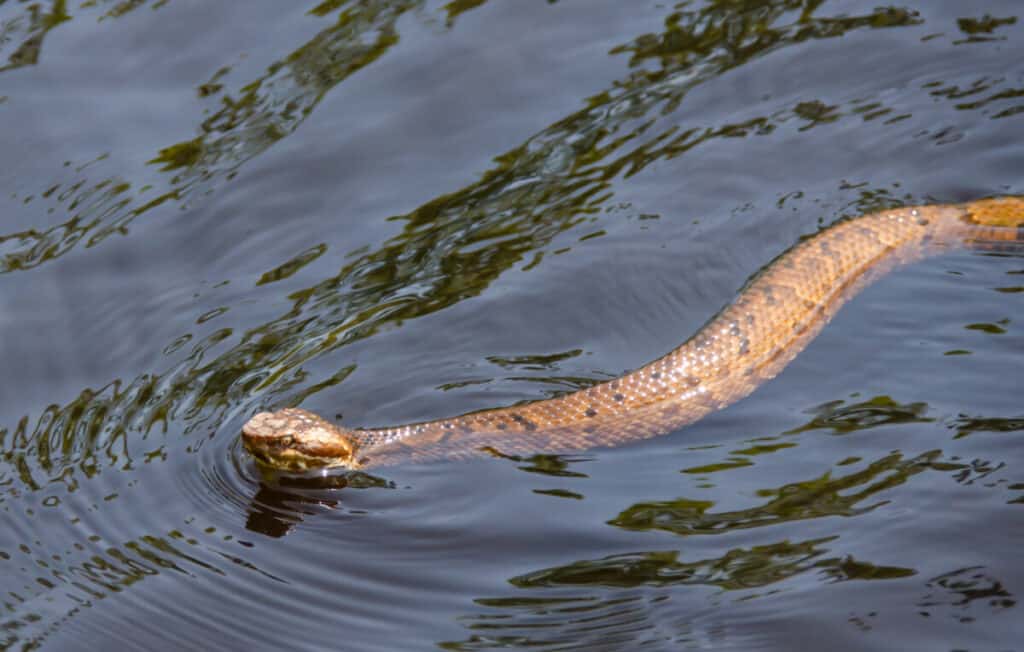
If you are an outdoorsy person who likes to travel everywhere, it’s good to know if there are any species of snakes in that area and if they are venomous or not. If you are planning on taking your next adventure outdoors, you might run into a cottonmouth snake. But are cottonmouths venomous and how dangerous are they?
Cottonmouth snakes, also known as water moccasins, are an extremely venomous kind of snake found in the southeastern United States. If a cottonmouth is spotted in the wild, make sure to keep a safe distance. If bitten by a cottonmouth snake, call 911 immediately and seek medical attention.
Cottonmouths are one of the four major venomous snakes in the U.S. The other venomous snakes include rattlesnakes, copperhead snakes, and coral snakes. You’ll want to make sure you have all the information you need on cottonmouth snakes before you go on your next outdoor adventure.
What Does a Cottonmouth Look Like?
In order to avoid this dangerous snake, you’ll need to be able to identify it.
The reason cottonmouths are called cottonmouths is due to the white coloration inside their mouth that they show when they feel threatened. Cottonmouth snakes, also known as water moccasins, have a unique shape to them. The cottonmouth is typically 24 inches to 48 inches long and can sometimes even be slightly larger; males will be larger than females.
They have a large triangular head and large jowls that allow them to hold and excrete venom. Their eyes are typically very dark and have a black line going vertically through the middle of them. They also have pits in their faces—this allows them to detect variations in heat so they can accurately strike their prey.
The coloration of a cottonmouth varies. These snakes can have a brownish yellow color with dark lines or they can be one solid color, usually black or brown. The younger cottonmouths will usually have more patterns to them compared to adult cottonmouths who typically are solid colors. The underbelly of these snakes tend to be lighter in color and have dark splotches on them, but some don’t have this at all.
Non-Venomous Snakes Are Often Mistaken For Cottonmouths
Sometimes typical harmless water snakes are confused with cottonmouths. The way to tell a water snake apart from a cottonmouth is their difference in size. Cottonmouths typically are very large and tend to have a thicker body, while water snakes are thinner and will have longer, more slender tails. Water snakes also have round eyes rather than catlike ones, and they do not have pits in their faces.
Cottonmouths also have a more triangular head and sharp eyes. Either way, you should probably avoid contact with any snakes you see in the wild unless you are a wildlife expert who knows what they are doing.

Where Do Cottonmouths Live?
Cottonmouth snakes usually live in the southeastern part of the United States. These states range from southeastern Virginia to Florida and clear into parts of Texas, Illinois, and Indiana. Growing up in Texas I have seen hundreds of cottonmouths.
Cottonmouths are semi-aquatic, so they prefer to be around bodies of water or in humid environments. Cottonmouths are the only venomous snakes in the United States that like to be on both land and in the water. You can typically find cottonmouths in any kind of body of water, this can include swamps, ponds, lakes, and streams.
It has been noted that cottonmouths can be seen throughout the entire day, this includes day and night. Cottonmouths do prefer to hunt for their prey after dark though. They can be seen during the day basking in the sun and taking in the warm weather.
So watch out for the venomous snakes especially when out fishing, swimming, or out near a body of water.
Are Cottonmouths Aggressive?
Cottonmouths are not typically aggressive, and it is extremely rare for a cottonmouth to bite a human. These snakes usually keep to themselves unless provoked or threatened. They are territorial, so keep out of their space! When I say they are not typically aggressive I mean that they are not going out of their way to attack humans.
This does not mean that they will not attack when they feel threatened. On some occasions, you might be in proximity to a cottonmouth without even seeing it and it might feel threatened. So watch out for these venomous snakes when you are out. After all, cottonmouth venom is very powerful.
Cottonmouths usually give a warning before striking, and this warning usually includes the cottonmouth coiling up and showing its mouth. Another way cottonmouths warn prey is by excreting a foul smell from the glands in their tail.
How Venomous Are Cottonmouths and What to Do if Bitten?
The venom of a Cottonmouth is quite potent and can cause serious side effects, such as local tissue necrosis and coagulopathy, which affects the blood’s ability to clot. (Source)
Cottonmouth bites are deadly to humans if proper actions are not taken quickly. If you or someone you know is bitten by a cottonmouth, you need to seek medical help immediately. Call 911 right away and follow the instructions they give you. You need to be taken to a hospital where you can be given antivenom as soon as possible.
“Antivenom is the treatment for serious snake envenomation. The sooner antivenom can be started, the sooner irreversible damage from venom can be stopped.”
-CDC (Centers for Disease Control and Prevention)
Stay calm and wait for help. Make sure you are away from the cottonmouth that has bitten you because they can strike again. Lay down or sit in a comfortable position, as venom can sometimes cause dizziness. Try to keep your heart rate low to slow down the spread of the venom throughout your bloodstream.
If you have rings or anything restricting or covering the area of the bite, make sure you remove those or cut any clothing before swelling happens. If you have water and even soap, make sure you wash the bite to prevent any bacteria from entering the wound.
Make sure you follow all of the snake bite protocols and do NOT handle the venomous snake, even if it is dead or has been decapitated. Wait for a medical professional to give you details on what you should do.
Water Moccasins Are Highly Venomous
Although cottonmouth snake bites are rare, they can happen. When you are outdoors in the southeastern United States and happen to run into a cottonmouth, make sure you keep your distance and leave the snake alone.
If you do happen to be bitten by a cottonmouth snake, seek medical help right away and follow the protocol for the venomous bite. If you need more information on cottonmouths and their venom, go to the CDC website.
